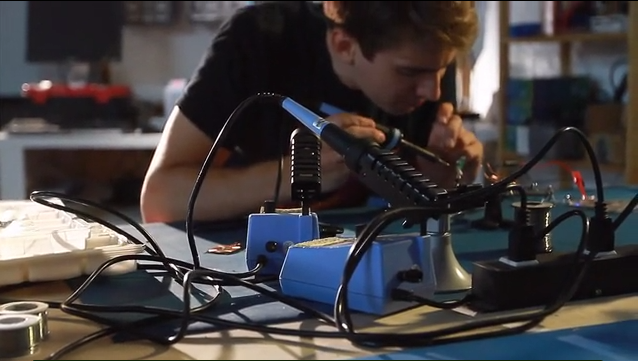Belle Holder

 Tyler McGahee is a maker with a background in aerospace engineering who specializes in things that fly themselves, and says the biggest challenge for him is finding enough time for all his ideas.
Tyler McGahee is a maker with a background in aerospace engineering who specializes in things that fly themselves, and says the biggest challenge for him is finding enough time for all his ideas.What do you do? I design and build flying robots that fly missions without a human operator. I’ve dabbled in solar powered planes, “ruggedized” systems, and using hyperspectral cameras. I’m currently working on web based software that helps hobbyists make their designs more efficient.
How long have you been making? I’ve been making since right after high school. I had been designing for a long time, but didn’t have the chance to make much. When I got my first job, I started buying different tools to make my projects come to life.
job, I started buying different tools to make my projects come to life.
Where did you learn to make? When it comes to the obscure tools, the DIY production methods and most maker type things, I am self taught (with the help of the web, of course!) – Arduino, vacuum forming, scroll sawing, resin. I also have a degree in Mechanical/Aerospace engineering that gave me the skills in design and more advanced manufacturing.
What is something people wouldn’t guess about your work? I keep very strict documentation and revision control, and I usually write final design reports. These really help me maintain rigor in the project – I don’t like to make decisions without at least some small consideration to the options, and, if it doesn’t work out, it helps to understand why.
What is your go to tool? A Logitech M570 wireless trackball mouse. I cringe at the thought of using an optical mouse or trackpad.

The Mil-Spec Quadcopter
What is your favorite build? MIL-Spec Quadcopter. It was one of my senior projects in engineering school, and it was the one that really launched me into autonomous UAVs. I actually joined the project because there were interesting challenges to solve – I wasn’t particularly passionate about flying robots at the time.
What was your goal for this project? Come to think of it, the goal was just “a quadcopter that can survive crashes from 40 feet” with good flight times. The final product definitely survived that and more, but it ended up being a bit too heavy. Making this project’s next generation is on my to-do list.
What was the hardest part of this project? Cost overruns – because we were only making one prototype, the cost for materials was 3-4 times as much as building ten of them. Our advisers were not very happy with us.
What is something people wouldn’t guess about it? I had a great team of electrical engineers on the project, and they decided that they wanted to design absolutely all of the electronics from scratch – the flight control, the sensor integration, the power distribution, etc. It was a lot more work than I thought necessary, but they put a lot into it and got a lot out of it.
What was the best story you got out of this project? As a validation test to see if the system could survive crashes, we strapped two pounds of steel to the frame and dropped it off a four-story building. Apparently my team members didn’t realize I was serious about doing this test, and they weren’t too happy about it. The frame not only survived, though, it actually bounced back with no injuries whatsoever.
“If you do what you love, you’ll never work a day in your life.”